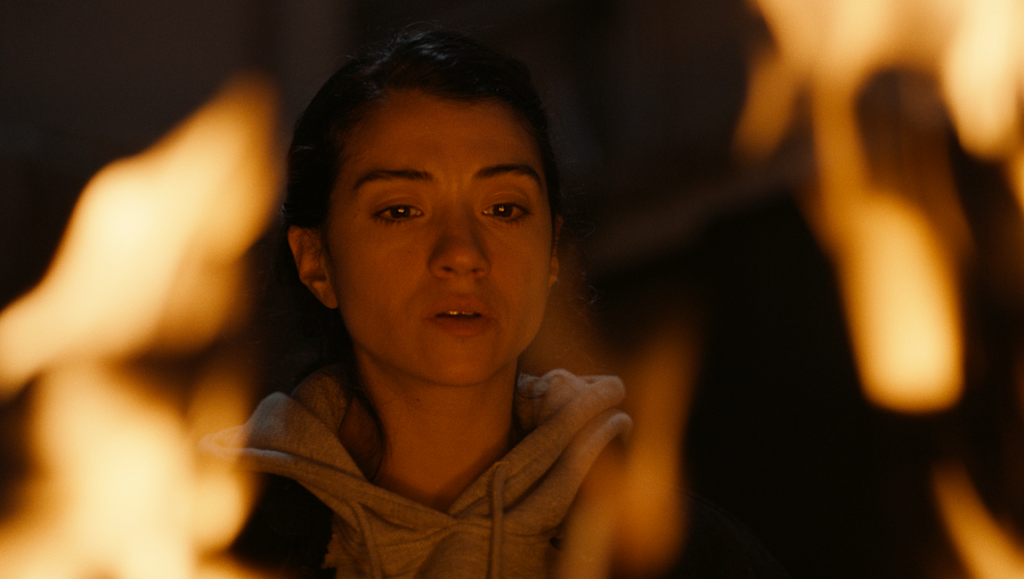Youssef Chebbi’s horror-tinged police procedural Ashkal (being released in the States officially as Ashkal: The Tunisian Investigation) begins with a brief explanation of The Gardens of Carthage, a neighborhood in the north of Tunisia “first built for dignitaries of the old regime” that “was meant to become a modern, rich city.” But in December 2010, the Tunisian Revolution began, leading to the fall of President Ben Ali and the cessation of construction on the site. Now, over a decade later, intermittent construction has resumed, leading to a patchwork of edifices in various forms of completion. The first image of Chebbi’s film is of a huge building, weathered with age, its various windows creating a patchwork of deep, recessed black squares peppered across its facade. It’s a visually striking opening, but also sets the film’s aesthetic priorities: harsh geometry, devoid of color, and largely absent human presence. Indeed, buildings are arguably more important here than any of the film’s actual characters. It’s like an anti-city symphony — not a celebration, but a funeral dirge.
Detectives Fatma (Fatma Oussaifi) and Batal (Mohamed Grayaa) are introduced as they are poking around a crime scene. One of the night watchmen at the construction site has been burned alive, his clothes piled neatly next to the charred husk of a body. There are no signs of a struggle, and the detectives’ superiors want a speedy resolution to the investigation. All signs point to suicide, but Fatma and Batal aren’t so sure. As they begin asking questions, much to the chagrin of their fellow officers, Ashkal reveals more and more layers of its overwhelmingly bleak narrative. Modern-day Tunisia is stricken by the same harsh divide between the haves and have nots as everywhere else; here, it’s the day laborers who are an exploited underclass while wealthy real estate agents and land developers stand to make big bucks from the rejuvenation of the Carthage project. Further, Fatma is ostracized from the rest of the police force; her father is part of a truth and reconciliation board that is investigating police misconduct under the Ali regime — the former president died in Saudi Arabia almost a decade after his ousting, having been tried and convicted in absentia of various crimes but never actually serving any time. More than just a symbol, the buildings of Carthage are a very real reminder of a precarious society brimming over with resentments and the festering wounds of a dictatorship.
Chebbi and cinematographer Hazem Berrabah work overtime creating an oppressive mood; the harsh geometry of the architecture divides and isolates human figures from one another, while huge cranes hover in the sky as if perilously perched on ledges. Characters traversing barren streets seem swallowed up by a void, surrounded by rubble or the local wildlife hovering ominously on the periphery. The impression very much recalls a Kiyoshi Kurosawa film, including his remarkable ability to turn simple urban cityscapes into uncanny liminal spaces. The plot thickens, so to speak, when the detectives discover a second and then a third immolated body. It’s unclear what’s driving people to set themselves on fire, once a traditional (if extreme) act of protest rendered here stranger and more oblique. As Fatma realizes, there’s not much point to immolation if it’s done secretly, in isolation, and there are certainly easier ways to kill oneself.
In an interview with Wilfred Okiche, Chebbi states “The police in Tunisia are a huge problem. They are everywhere and can easily target you. Whether we admit it or not, it is still a corrupt institution. But the corruption in Tunisia is not only about cops. It is also about the political systems that we had with Ben Ali, such that after the revolution, corruption became a part of everyday life, and has come to be deeply entrenched.” In a very real sense, then, the city of ghosts that is Carthage becomes both literal and symbolic, representing a corrupt past, but also pointing toward an equally corrupt future. Eventually a figure does appear, although the film is vague about whether they are a villain or something altogether unknowable. Hypnotic sequences of immolation are hard to watch, but come to signify a kind of purification. Whether or not these flames are ones of destruction or of a Phoenix-like rebirth are impossible to know — only the future will be able to tell us.


Comments are closed.